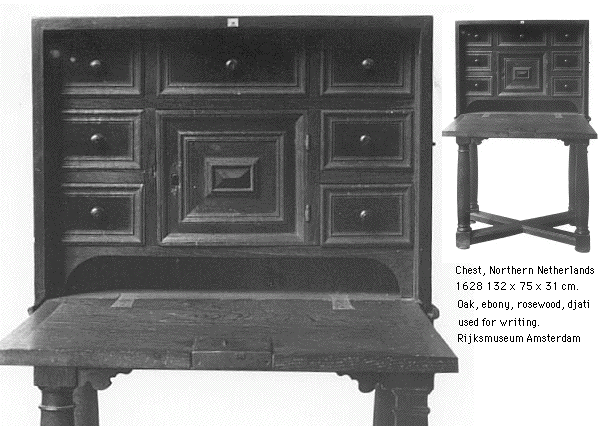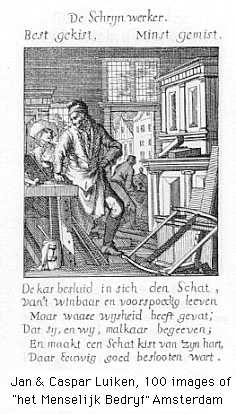
A cabinet of jointry work, een schrijnwercktkasie ; In the forehouse ("voorhuys") Room A.

Joiners or cabinet makers are specialized in cabinet making. In their craft they use complex mitres and joints. In many Dutch towns these techniques were not allowed for common carpenters ('witwerkers'). For 'witwerkers' see the Obreen list under "Artists and Patrons".
As a result of foreign trade exotic types of wood became available after 1600, such as ebony. Joiners also made paneling and wainscoting in rooms (Fock, 2001, p. 29).
See photo above. Other examples are:
- an ebony inlay cabinet. Size 202 x 174 x 74,5 cm Rijksmuseum, inventory numbers RBK 1959-47 (hier niet afgebeeld).
- Table chest, Northern Netherlands, palissander, ebony and oak. Rijksmuseum, inventory number BK NM 11190 M cat 98 1017 (niet afgebeeld).
 Note
: A 'witwerker' is a carpenter who makes
pine furniture and joined them with nails only, not using mitres and
joints and neither using glue, for that technique was reserved for
cabinet makers, 'schrijnwerkers'. Information per e-mail Dec. 1 2002
by Hans Piena, furniture restorer and advisor on conservation,
Gelders Oudheidkundig Contact, Zutphen, The
Netherlands.
Note
: A 'witwerker' is a carpenter who makes
pine furniture and joined them with nails only, not using mitres and
joints and neither using glue, for that technique was reserved for
cabinet makers, 'schrijnwerkers'. Information per e-mail Dec. 1 2002
by Hans Piena, furniture restorer and advisor on conservation,
Gelders Oudheidkundig Contact, Zutphen, The
Netherlands.
A 2010 BBC programme showed Green Woodworkers who created furniture out of freshly cut trees without the use of glue, or nails.]
This object was part of the Vermeer-inventory as listed by the clerk working for Delft notary public J. van Veen. He made this list on February 29, 1676, in the Thins/Vermeer home located on Oude Langendijk on the corner of Molenpoort. The painter Johannes Vermeer had died there at the end of December 1675. His widow Catherina and their eleven children still lived there with her mother Maria Thins.
The transcription of the 1676 inventory, now in the Delft archives, is based upon its first full publication by A.J.J.M. van Peer, "Drie collecties..." in Oud Holland 1957, pp. 98-103. My additions and explanations are added within square brackets [__]. Dutch terms have been checked against the world's largest language dictionary, the Dictionary of the Dutch Language (Woordenboek der Nederlandsche Taal , or WNT), which was begun by De Vries en Te Winkel in 1882. In 2001 many textile terms have been kindly explained by art historian Marieke te Winkel. C. Willemijn Fock, Titus M. Eliëns, Eloy F. Koldeweij, Jet Pijzel Dommisse, Het Nederlandse interieur in beeld 1600 - 1900 Waanders, Zwolle 2001, p. 29.
This page forms part of a large encyclopedic site on Vermeer and Delft. Research by Drs. Kees Kaldenbach (email). A full presentation is on view at johannesvermeer.info.
Launched December, 2002; Last update March 2, 2017.
Back to the Welcome page: click Welcome.